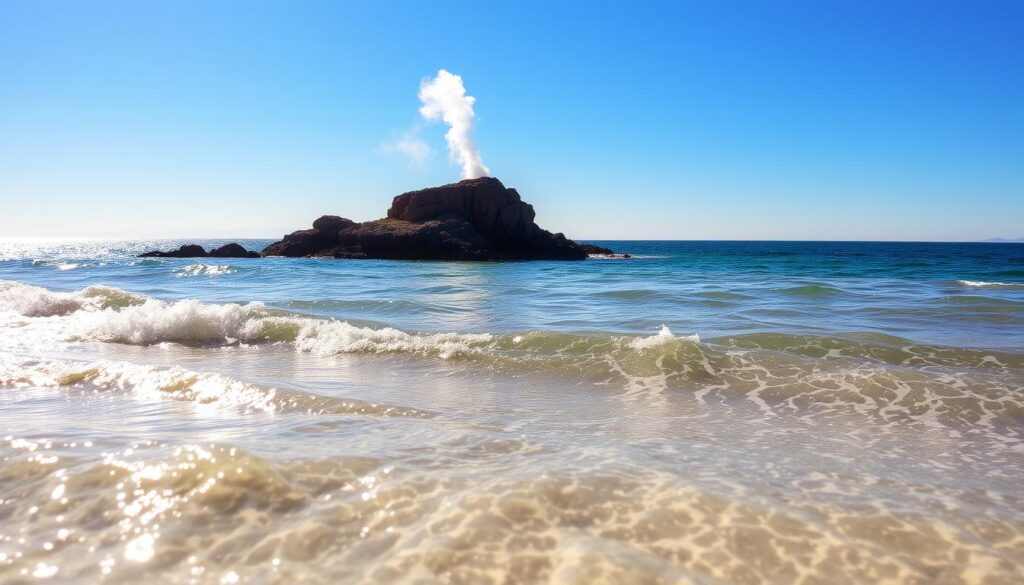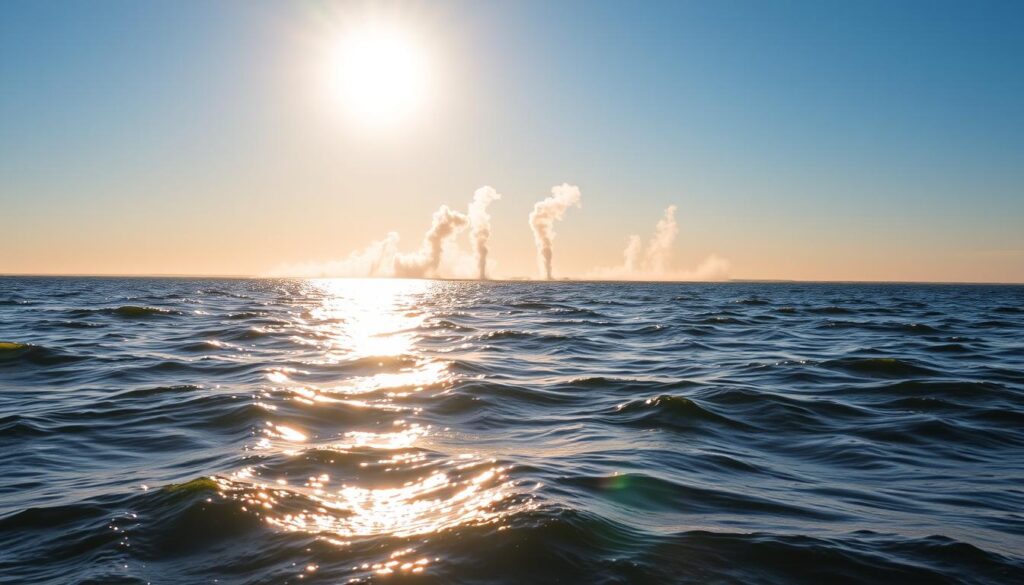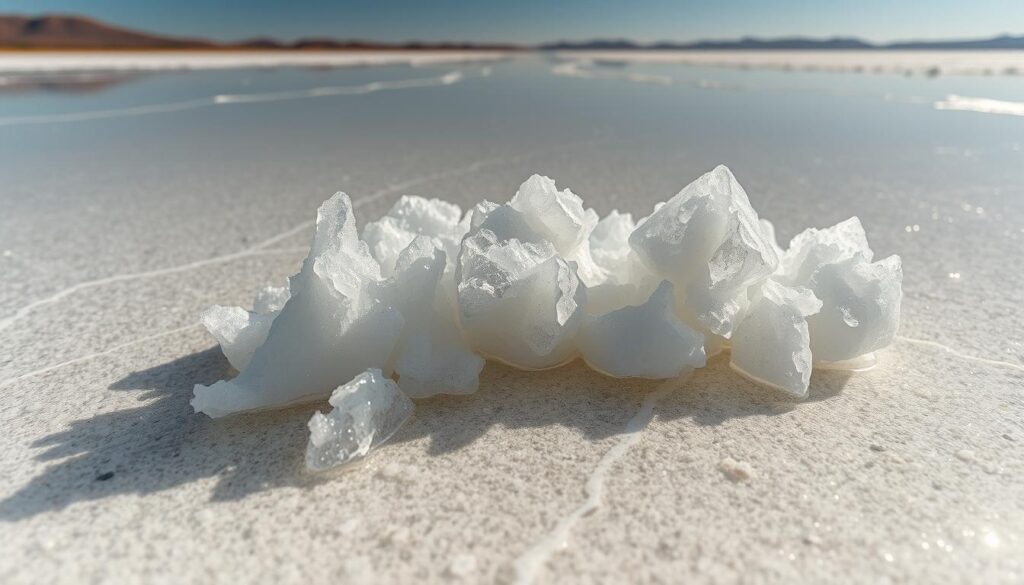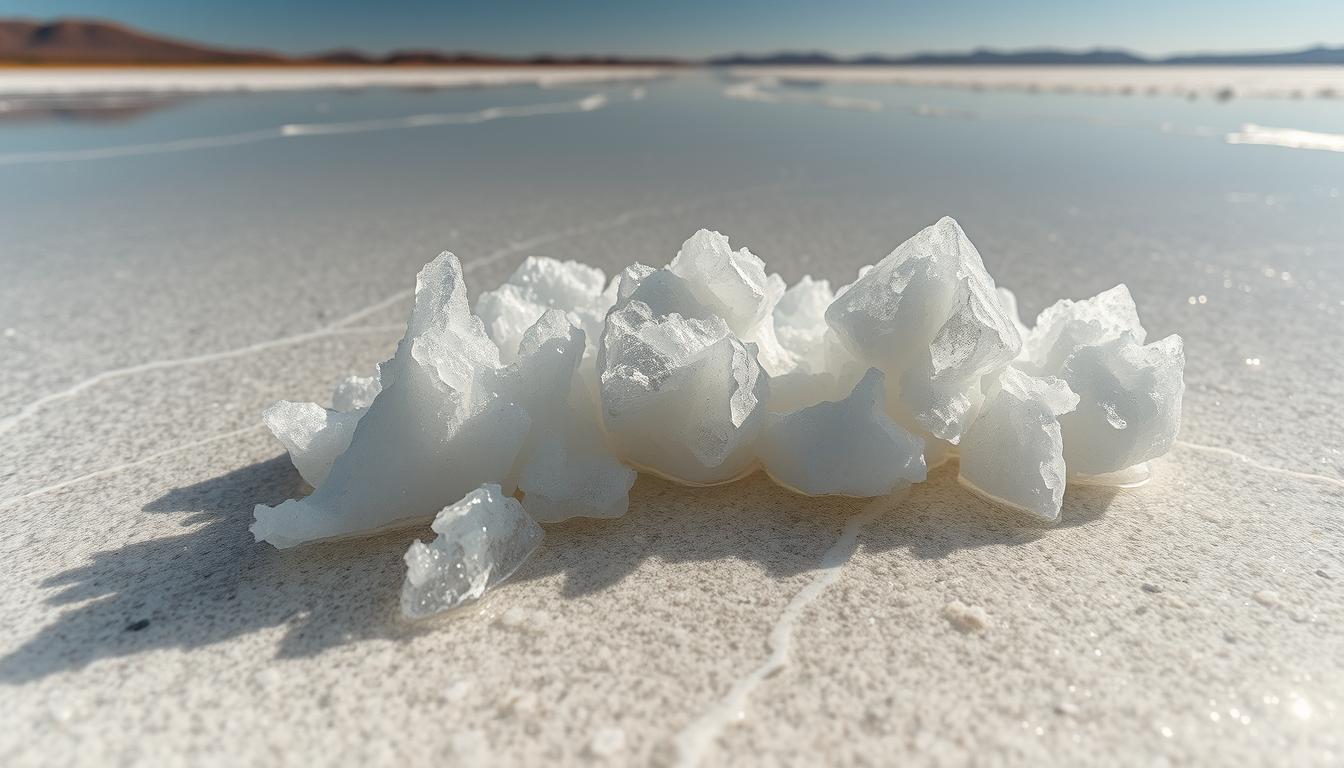Ocean water evaporation is key to the water cycle. It’s important to understand this process to grasp our environment’s complexity. The evaporation process shapes our planet’s climate and weather.
As we explore ocean water evaporation, we’ll look at what affects it. This includes temperature, solar radiation, and wind on evaporation rates.

The water cycle is complex, and ocean water evaporation is a big part of it. By studying evaporation, we learn about the ocean, atmosphere, and land’s balance. In this article, we’ll talk about what affects ocean water evaporation. This will help us understand the intricate relationships between these elements.
Key Takeaways
- Ocean water evaporation is a critical component of the water cycle
- The evaporation process is influenced by temperature, solar radiation, and wind
- Understanding ocean water evaporation is essential for grasping climate and weather patterns
- The water cycle is an intricate system that relies on the balance between ocean, atmosphere, and land
- Examining the evaporation process can provide insights into the complex relationships between these elements
Understanding the Basics of Ocean Water Evaporation
Ocean water evaporation is a key part of the global water cycle. It’s important to know what affects how fast water evaporates. This includes ocean temperature, solar radiation, and wind speed. Together, these factors decide how quickly water turns into vapor from the ocean’s surface.
The energy from solar radiation heats water molecules, turning them into gas. The ocean temperature also matters, as warmer water evaporates faster. Plus, wind speed helps by spreading water vapor, letting more molecules evaporate.
- Water temperature
- Solar radiation intensity
- Wind speed and direction
- Air humidity
These factors change based on where you are and the time of year. This means evaporation rates vary all over the world.
Knowing how ocean water evaporation works helps us understand the global water cycle better. By seeing how ocean temperature, solar radiation, and wind speed affect it, we get a clearer picture of our planet’s water systems.
The Science Behind Why Ocean Water Evaporates in Minutes
Ocean water turning into vapor is a complex process. It’s a key part of the water cycle, helping to spread heat and moisture worldwide. Several factors, like heat, humidity, and wind, affect this process.
The sun’s heat is a major factor in ocean water evaporation. When the sun warms the ocean’s surface, it changes the water into vapor. Wind helps spread this heat and moisture, speeding up evaporation. However, high humidity can slow it down.
Here are some key factors that affect the evaporation process of ocean water:
- Heat from the sun
- Wind movement
- Humidity levels
- Salinity of the ocean water
The evaporation of ocean water is vital for the global water cycle. It helps distribute heat and moisture, influencing climate and weather. Knowing how ocean water evaporates is key for weather forecasting and water management.
In conclusion, ocean water evaporation is a complex process. It’s influenced by heat, humidity, and wind. This process is crucial for the global water cycle.
Temperature’s Impact on Evaporation Speed
Ocean temperature greatly affects how fast water evaporates. When the ocean temperature goes up, so does the evaporation rate. This is because warm water molecules have more thermal energy and can turn into vapor more easily.
The heat transfer from the sun to the water also speeds up evaporation. This energy helps water molecules turn into vapor.
The link between temperature and evaporation is clear. As the ocean temperature rises, more heat transfer happens. This leads to faster evaporation. Understanding this is key to grasping the global water cycle and its impact on our planet.
Several factors influence how temperature affects evaporation speed. These include:
- Surface temperature effects: The ocean’s surface temperature is crucial for evaporation rates.
- Air temperature influence: The air temperature above the ocean also matters. It affects how fast water vapor rises.
- Thermal energy transfer process: The way energy moves from the sun to water molecules is vital for evaporation.
By understanding temperature’s role in evaporation, we can see the complex links between the ocean, atmosphere, and global water cycle. The heat transfer and thermal energy are key. Changes in temperature can greatly impact our environment.
How Solar Radiation Accelerates Water Evaporation
The process of ocean water evaporation is greatly influenced by solar radiation. When the sun’s energy hits the Earth’s surface, it warms the ocean water. This starts the evaporation process.
This energy transfer is key. It gives water molecules the heat needed to turn from liquid to gas.
When solar radiation is strong, it makes the ocean water even hotter. This boosts the evaporation rate. More water vapor ends up in the atmosphere.
The link between solar radiation and evaporation is intricate. It involves many factors that impact how fast ocean water evaporates.

- Intensity of solar radiation
- Temperature of the ocean water
- Humidity levels in the atmosphere
These elements work together, shaping the evaporation rate. Knowing how solar radiation affects evaporation is vital. It helps us understand ocean water dynamics and its environmental impact.
The Role of Wind and Air Movement
Wind and air movement are key in evaporation. Wind speed is especially important. Faster winds help move heat and energy from the surface to the air, boosting evaporation.
Stronger winds can also break up water surface tension. This lets more water molecules move into the air.
Air pressure also affects evaporation. Low pressure systems usually mean more moisture in the air. This can slow down evaporation because the air can’t hold as much moisture.
Key Factors Influencing Evaporation
- Wind speed: Increased wind speed enhances heat and energy transfer, leading to higher evaporation rates
- Air pressure: Changes in air pressure influence moisture levels in the air, impacting evaporation rates
- Atmospheric circulation: Global wind patterns and atmospheric circulation patterns can distribute heat and moisture, affecting regional evaporation rates
It’s vital to understand how wind speed, air pressure, and atmospheric circulation work together. This knowledge helps us predict evaporation and manage water better. By grasping these interactions, we can improve our water management strategies.
Salinity’s Influence on Evaporation Rates
The salinity of ocean water greatly affects how fast water evaporates. Salinity is the amount of salt in ocean water. The more salt, the slower the evaporation.
Here are some key factors to consider when examining the relationship between salinity and evaporation rates:
- Salinity levels: Higher salinity levels can reduce the evaporation rate of ocean water.
- Evaporation process: The evaporation process is influenced by the concentration of salt in ocean water.
- Ocean water: The salinity of ocean water varies depending on factors such as location and depth.

In conclusion, understanding how salinity affects evaporation is key to understanding ocean water. Recognizing salinity’s role in evaporation helps us see the complex relationships in our ocean ecosystems.
Humidity Levels and Their Effect on Ocean Evaporation
Humidity levels are key in ocean evaporation. The moisture in the air, or relative humidity, can speed up or slow down evaporation. Let’s explore how these factors affect ocean evaporation.
The link between humidity levels and evaporation is intricate. High relative humidity can slow evaporation because the air is full of water vapor. But, low relative humidity can boost evaporation since the air can hold more vapor. Vapor pressure also plays a role, influencing how water turns into vapor.
- Air temperature
- Wind speed
- Salinity levels
These elements can either increase or decrease the effect of humidity levels on ocean evaporation. Understanding these interactions helps us grasp the complex ocean evaporation processes.
Conclusion: Understanding Ocean Water’s Dynamic Nature
The ocean’s waters are always changing, with evaporation being key to the global water cycle. Temperature, solar radiation, wind, and salinity all play roles in this complex process. Understanding these factors helps us see how the ocean keeps our planet’s water in balance.
The oceans, being the largest bodies of water, drive the water cycle. They add moisture to the air and bring rain to the land. The fast evaporation of ocean water shows how crucial it is for our climate and life on Earth. By learning about this, we can better appreciate the ocean’s role and why we must protect it.
FAQ
What is water evaporation?
Water evaporation is when water turns from liquid to gas, called water vapor. This happens when it absorbs heat energy.
What is the role of ocean water in the global water cycle?
Ocean water is key in the global water cycle. It’s the main source of water that evaporates and turns into rain. This rain then fills up the Earth’s freshwater supplies.
What factors affect the rate of ocean water evaporation?
Several factors influence how fast ocean water evaporates. These include the ocean’s temperature, how much sunlight it gets, wind speed, and humidity levels.
How does surface temperature affect evaporation speed?
The ocean’s surface temperature greatly affects evaporation. Warmer water has more energy. This makes it easier for water to turn into vapor.
What is the role of solar radiation in accelerating water evaporation?
Solar radiation, or sunlight, is crucial for evaporation. It gives water the heat it needs to turn into vapor.
How do wind and air movement influence evaporation rates?
Wind and air movement are important for evaporation. They help move water vapor away from the ocean’s surface. This lets more water evaporate.
How does salinity affect evaporation rates?
Salinity, or the salt content in ocean water, can change evaporation rates. More salt can make water harder to evaporate because it affects the water’s boiling point.
How do humidity levels impact ocean evaporation?
Humidity, or the amount of water vapor in the air, greatly affects evaporation. The difference in vapor pressure between the water and air determines how fast water evaporates.
